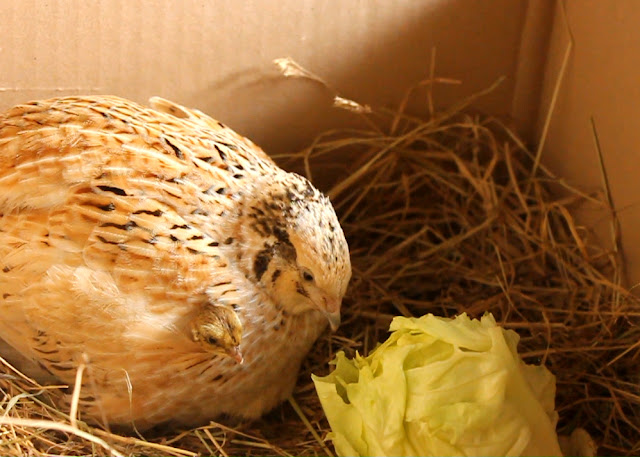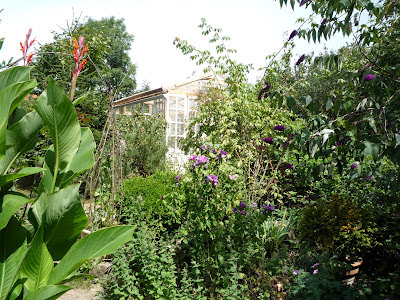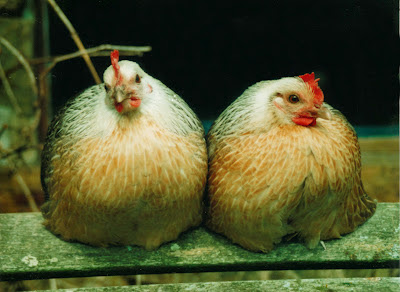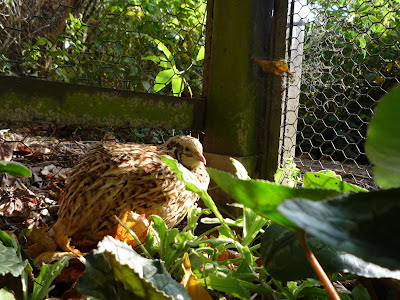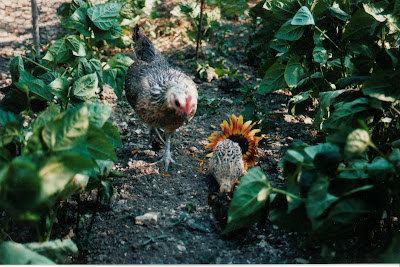Polly and the quail at three days old and already something of a
handful! I kept them in the nest for the first three days, letting them
gain in strength and size and because Polly is so trusting and so
understanding she complied. This would be against her better judgement
because, normally once her eggs have hatched and all the chicks are on
their feet a mother hen will be ready to leave the nest and take the
chicks out to forage.
To make it easier for Polly to comply, I made sure there was a continual supply of varied foodstuffs and water and of course continued to take her off the nest twice a day. When I took the above photograph they were still all in the nest but sitting in the doorway in full sunlight - getting some rays!
Sitting is easy it's after hatching that the fun starts!
 My problem has always been in obtaining organic hatching eggs, so I have had to take what I could get. Most quail are hatched in incubators and to some extent a poor quality shell, due to inadequate diet and lack of Vitamin D from sunlight, isn't that much of an issue. However, an egg that is turned by a hen several times a day and may be trod on as she gets in and out of the nest is a problem. To counter this, I lift my hen on and off the nest, twice a day, once in the morning and once at night. I'm amazed, though I shouldn't be, how careful most hens are with quail eggs and it's usually when I have flustered the hen that I have had broken eggs. With Polly because of the experience with her Mother, who didn't take to the eggs immediately, I put a hen's egg into the nest as well and had an extra broody standing by to take over with it once the quail eggs hatched at 19 days. Seeing them together in the nest really illustrates the difficult task the hen has been given!
My problem has always been in obtaining organic hatching eggs, so I have had to take what I could get. Most quail are hatched in incubators and to some extent a poor quality shell, due to inadequate diet and lack of Vitamin D from sunlight, isn't that much of an issue. However, an egg that is turned by a hen several times a day and may be trod on as she gets in and out of the nest is a problem. To counter this, I lift my hen on and off the nest, twice a day, once in the morning and once at night. I'm amazed, though I shouldn't be, how careful most hens are with quail eggs and it's usually when I have flustered the hen that I have had broken eggs. With Polly because of the experience with her Mother, who didn't take to the eggs immediately, I put a hen's egg into the nest as well and had an extra broody standing by to take over with it once the quail eggs hatched at 19 days. Seeing them together in the nest really illustrates the difficult task the hen has been given!
 I took this shot later when the quail and Polly moved out into the warmest of the Greenhouses (recycled glass and pallet wood). From it you can see the relative size of the Ardenner and my adult quail (behind the compost bag). I had hoped to keep this female quail in the Greenhouse at the same time as Polly so she could integrate with the baby quail but Polly was having none of that and I had to separate them.
I took this shot later when the quail and Polly moved out into the warmest of the Greenhouses (recycled glass and pallet wood). From it you can see the relative size of the Ardenner and my adult quail (behind the compost bag). I had hoped to keep this female quail in the Greenhouse at the same time as Polly so she could integrate with the baby quail but Polly was having none of that and I had to separate them.
Some thoughts about choosing a broody for quail

I couldn't have asked for a better hen to sit quail than Polly our Ardenner bantam but she certainly had her work cut out. If you haven't come across the Ardenner before, as the name suggests, it is an ancient and very rare breed from Southern Belgium. The larger version had existed for centuries but along with the bantam was almost extinct after the two World Wars, in fact, I have never come across the Standard size Ardenner. The Breed are known for being great foragers, good layers and excellent mothers and I can vouch for all three of those qualities, they are also, in my experience hyperactive, which makes them totally suitable as surrogate Mothers for quail. At the other end of the scale, as possibly the worst bantam Mother is the Sebright, a race which is reputed for only staying with chicks for four weeks after hatching and I have had experience of this too. However, the Sebright cross bantams make excellent Mothers and the Sebright/Ardenner crosses are fantastic with quail. In particular they are lighter than the Ardenner and also have finer feathering both of which characteristics are a plus when raising quail.

This is Lucky and her favourite quail chick Pip, they were inseparable and I could free-range Pip with Lucky and know he would always be within a few centimetres of her. As a Sebright/Ardenner cross Lucky was probably half the weight and certainly half the size of an Ardenner. Weight can be a big issue with rising quail, in particular if your hen does not realise how delicate quail are in the first few days of life. Both Polly and Lucky were really good at understanding this, don't ask me how they knew to be very much more careful with quail, they just did. As an example of how incredible mother hens can be, I once had a hen called Dorothy whose chicks use to sit on her back even when she was walking about. One night when they were going to bed, two chicks were still standing on her back as she entered their little house. Before I could intervene, she actually got down and walked in on her hocks because she realised that the chicks would be knocked off her back if she didn't - how did she work that out? This sort of consciousness, which tells her that the chicks were higher than her head, which was level with the height of the door, is quite abstract. Moreover, it was the speed with which she realised what she needed to do, which quite astounded me.
Problems with hatching eggs
Unless you can not do otherwise, it is best to go and fetch your eggs if you live more than a day's posting from the seller. I have never found eggs which come by post to have a high hatching rate and I have read that after four days the fertility of the eggs starts to diminish significantly. If you think about quails in the wild they can lay and sit very large clutches so the first eggs in a clutch may be over a fortnight older than the last egg laid but that wild quail will be on an optimum diet and living in an optimum environment.
Nutritional problems to watch out for in the first few days
 If you've been lucky enough to get hold of certified organic hatching eggs or eggs from a smallholding where the quail are kept outside and on a good natural diet then you won't come across nutritional problems. Eggs reflect totally the health of the bird who laid them. The main deficiencies I have come across are Vitamin B and Selenium, the latter seems most prevalent in domesticated commercial gamebirds in particular quail and peafowl. Vitamin B deficiency is something I've come across before in purchased fertile hens' eggs. A couple of days after hatching the chicks start to go down on one hock, begin to sit down frequently and finally lose the use of their legs and most often their toes curl up, hence the name 'curly toe paralysis'. This condition like many nutritional deficiencies in small growing chicks can be fatal but is easily and quickly remedied by balancing the diet. My thinking is that we are taking a weak chick and giving it a quite energetic and outdoor foraging life, if it was hatching in an incubator and kept in a cage on a chick ration it would probably survive a little longer before the symptoms show. In the life it will have with a Mother hen, these symptoms show quickly. I feed yeast flakes, actually chicks seem to like the flavour but I have gone so far as to sprinkle it onto an egg yolk, another good food for baby quail. Selenium deficiency again affects the nervous system and causes paralysis. The best form of Selenium is the brazil nut, however you only need the tiniest (3-4) fine gratings, as Selenium is actually toxic in large amounts and figuring what that means for a tiny quail is difficult. One way to know when your chicks may be suffering from either of these deficiencies is if you see your mother hen nudging the babies back onto their feet, it means she has noticed they are sitting too long. One of the ways in which hens naturally treat coccidiosis in chicks is to keep them on their feet and moving so that they eliminate the problem as quickly as possible.
If you've been lucky enough to get hold of certified organic hatching eggs or eggs from a smallholding where the quail are kept outside and on a good natural diet then you won't come across nutritional problems. Eggs reflect totally the health of the bird who laid them. The main deficiencies I have come across are Vitamin B and Selenium, the latter seems most prevalent in domesticated commercial gamebirds in particular quail and peafowl. Vitamin B deficiency is something I've come across before in purchased fertile hens' eggs. A couple of days after hatching the chicks start to go down on one hock, begin to sit down frequently and finally lose the use of their legs and most often their toes curl up, hence the name 'curly toe paralysis'. This condition like many nutritional deficiencies in small growing chicks can be fatal but is easily and quickly remedied by balancing the diet. My thinking is that we are taking a weak chick and giving it a quite energetic and outdoor foraging life, if it was hatching in an incubator and kept in a cage on a chick ration it would probably survive a little longer before the symptoms show. In the life it will have with a Mother hen, these symptoms show quickly. I feed yeast flakes, actually chicks seem to like the flavour but I have gone so far as to sprinkle it onto an egg yolk, another good food for baby quail. Selenium deficiency again affects the nervous system and causes paralysis. The best form of Selenium is the brazil nut, however you only need the tiniest (3-4) fine gratings, as Selenium is actually toxic in large amounts and figuring what that means for a tiny quail is difficult. One way to know when your chicks may be suffering from either of these deficiencies is if you see your mother hen nudging the babies back onto their feet, it means she has noticed they are sitting too long. One of the ways in which hens naturally treat coccidiosis in chicks is to keep them on their feet and moving so that they eliminate the problem as quickly as possible.
A few words about feathers

Sebright crosses have one huge advantage over Ardenners as Mummy Quail in that their feathering is much finer. When a bird goes broody she loses a lot of feathers off the breast so as to be in close contact with the eggs. Some hens, probably due to the added heat involved in brooding and raising chicks may go into a semi-moult. Even this, however, may still be problematic for quail if the Mother bird is well upholstered with feathers as is the Ardenner. There is a fine line in keeping the quail warm and not getting them dangerously caught up and almost strangled in the feathers. The first couple of days were rather fraught for me when I lifted Polly off the nest in the morning to find the quail entangled in her feathers and hanging by their necks. The problem being, from my observations, is that living amongst the feathers the quail droppings do stick the feathers together is how they get caught as they snuggle into the plumage. With the Sebright-type of smaller, finer feathers this does not occur. However, once I realised this problem could occur I could deal with it. Do be aware however, that this is a serious problem because on one very sad occasion Polly felt the quail dangling at her back and in panic, kicked out and killed it outright before I could release it.
How to avoid those busy hen's feet.
 I like to get baby birds outdoors as quickly as possibly, as soon as it hits 16 degrees C. I always tend to start them in a small run, as even at that temperature some baby chicks can still get cold. Sebright chicks in particular feel the cold keenly and they need the mother to be nearby if that happens. A good hen will always sit if a chick starts to try to get underneath her, she instinctively knows it is cold and/or tired. With quail in the past I have bought the outdoors in with a complex set of runs fitted with areas of grass and soil. However since Andy started making Greenhouses, it has given me an ideal place to put the quail in the first few days. The only thing to be aware of is dust baths because that will be the first thing a Mother hen wants to take. If you look at the film at the end of my previous post on quail you will see how I got round this by creating a run within the greenhouse so that the quail and Polly could still see each other whilst she was dust bathing.
I like to get baby birds outdoors as quickly as possibly, as soon as it hits 16 degrees C. I always tend to start them in a small run, as even at that temperature some baby chicks can still get cold. Sebright chicks in particular feel the cold keenly and they need the mother to be nearby if that happens. A good hen will always sit if a chick starts to try to get underneath her, she instinctively knows it is cold and/or tired. With quail in the past I have bought the outdoors in with a complex set of runs fitted with areas of grass and soil. However since Andy started making Greenhouses, it has given me an ideal place to put the quail in the first few days. The only thing to be aware of is dust baths because that will be the first thing a Mother hen wants to take. If you look at the film at the end of my previous post on quail you will see how I got round this by creating a run within the greenhouse so that the quail and Polly could still see each other whilst she was dust bathing.
 In those first few days in the Greenhouse I still supervised Polly and the quail and they needed to be brought back indoors into their nest as soon as they showed any signs of getting cold. You'll know when this is as baby quail are not shy and retiring when it comes to wanting something, they make an insistent whining noise when they are cold!
In those first few days in the Greenhouse I still supervised Polly and the quail and they needed to be brought back indoors into their nest as soon as they showed any signs of getting cold. You'll know when this is as baby quail are not shy and retiring when it comes to wanting something, they make an insistent whining noise when they are cold!
They also have an amazing ability to draw attention to themselves by extending themselves to their full height and making a piercing noise.
Something the males use to full effect in adulthood:
Thanks for dropping by and do feel free to share experiences or ask for further information in the comment section. If you have enjoyed this piece and found it useful think about sharing it with your family and friends, on social media and also maybe about joining this blog and/or subscribing to my Youtube, Odysee or BitChute Channel or even supporting us on Patreon or
It all helps to keep me going!
Until next time, all the very best from sunny Normandie!
Sue
Part Three of Hatching and Raising Quail Organically with a Mother Hen can be found here
RELATED ARTICLES
 Why and how? Getting started.
Why and how? Getting started.
I
had read that for centuries in Japan and China quail eggs had been used
in the treatment of various respiratory diseases and allergies.
Finding no organic eggs on the market, I decided to raise them myself...
read more
 How your hen can bring out the best in baby quail.
How your hen can bring out the best in baby quail.
Years
of selective breeding have not only bred the broodiness out of
domesticated quail but also their ability to identify and seek out their
own food.
read more
 A comprehensive guide into the history & use of quail eggs in medicine Part 1
A comprehensive guide into the history & use of quail eggs in medicine Part 1
How we cured Andy's hay fever and eczema with a dip into Ancient Egypt and 60's France...
read more
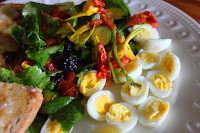 A comprehensive guide into the history & use of quail eggs in medicine Part 2
A comprehensive guide into the history & use of quail eggs in medicine Part 2
Now
we eat quail eggs for pleasure..here I look in depth at the clinical
trials in the 1960s and the posology used then and by us...
read more
 Thanks for dropping by and if you
have enjoyed this piece and found it useful think about sharing it and
also maybe about joining this blog. Please also feel free to ask
questions or make comments in the section below.
Thanks for dropping by and if you
have enjoyed this piece and found it useful think about sharing it and
also maybe about joining this blog. Please also feel free to ask
questions or make comments in the section below.
